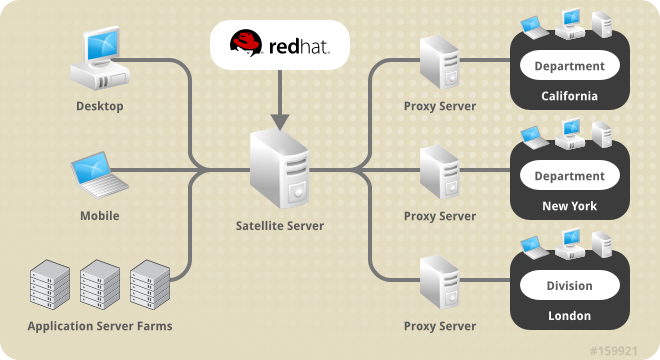1.2. System Overview
Red Hat Satellite consists of the following components:
- Red Hat Satellite Core
- The core system and entry point for Red Hat Update Agent running on client systems. Red Hat Satellite also includes an Apache HTTP Server, which serves XML-RPC requests.
- Red Hat Satellite Web Interface
- A user interface for advanced system, system group, user, and channel management. The organization configures access to the Red Hat Satellite web interface from the local area network and, optionally, the Internet too. Red Hat Satellite provides an interface similar to the Red Hat Network website and allows full control over client systems, system groups, and users.
- Database
- Red Hat Satellite uses one of the following database types:
- Embedded Database - The database comes bundled with Red Hat Satellite and is installed on the same machine as the Satellite during the installation process. The included database is PostgreSQL.
- Managed Database - The database comes bundled with Red Hat Satellite and is installed on a separate machine during the installation process. The included database is PostgreSQL.
- External Database - An organization's existing database or, preferably, a database contained on a separate machine. Red Hat Satellite supports PostgreSQL, Oracle Database 11g (Standard or Enterprise Edition), or Oracle Database 10g Release 2 (Standard or Enterprise Edition) for this database installation type.
- RPM Repository
- Package repository for Red Hat RPM packages and custom RPM packages identified by the organization.
- Management Tools
- The Red Hat Satellite Management Tools synchronize the database and package repository with Red Hat Network. Red Hat Satellite also includes management tools for:
- Database and file system synchronization
- Custom RPM and repository imports
- Channel maintenance (Web-based)
- Errata management (Web-based)
- User management (Web-based)
- Client system and system grouping (Web-based)
- Red Hat Update Agent
- The Red Hat Update Agent operates on client systems to retrieve updates from the organization's internal Red Hat Satellite. System administrators also schedule these actions through the Red Hat Satellite Web Interface.When a client requests updates, the organization's internal Red Hat Satellite queries its database, authenticates the client system, identifies updated packages, and sends the requested RPMs back to the client system. The client also installs these packages if set in preferences. The client system can send an updated package profile to the database on the Red Hat Satellite.
Important
Red Hat strongly recommends that clients connected to Red Hat Satellite be running the latest update of Red Hat Enterprise Linux to ensure proper connectivity. - Red Hat Satellite Proxy Server
- Use Red Hat Satellite in conjunction with Red Hat Satellite Proxy Server to create a distributed, self-contained Satellite environment for the organization. For example, an organization can maintain one Red Hat Satellite in a secure location while systems in proximity connect to it through local network access. Other remote offices would maintain Satellite Proxy Server installations that connect to the Satellite server. The different locations inside the organization require a networked connection, but this can be a private network; an Internet connection is not required for any of the systems. See the Red Hat Satellite Proxy Installation Guide for more information on installing and configuring Satellite Proxies.
Figure 1.1. Using Red Hat Satellite and Red Hat Satellite Proxy Server Together
- Enhanced Entitlements Reporting
- Red Hat Satellite 5 uses channels and system entitlement consumption to manage Red Hat content. Newer entitlement tools that integrate with the Red Hat Customer Portal, such as Red Hat Subscription Asset Manager, use certificate-based entitlements. The rules for these two types of entitlement methods differ.Red Hat Satellite 5.7 also provides an Enhanced Entitlements Reporting technology that integrates with certificate-based entitlement tools. This provides an overview of entitlement consumption from Satellite 5's system management while using newer certificate-based entitlement rules. This allows administrators to:
- Track entitlement consumption at a detailed level.
- Measure consumption based on socket count, host/guest relationships and channel usage
- Capture historical consumption data to enable system administrators to view which entitlements were consumed at a particular time as well as the status of entitlements at specific points in time.
Important
The Enhanced Entitlements Reporting functionality only provides reports on content consumption. It does not manage content consumption.Important
Enhanced Entitlements Reporting is only available for Red Hat Satellite 5.6 and later.
